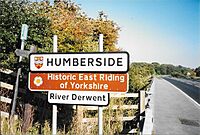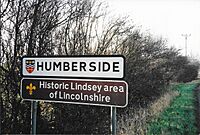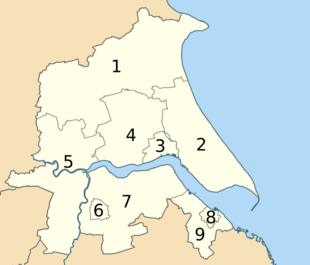Humberside facts for kids
| Humberside | |
| Motto: United we Flourish | |
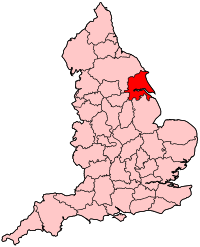 Humberside within England in 1991 |
|
| Geography | |
| Status | Non-metropolitan county |
| 1974 area | 867,755 acres (3,511.68 km2) |
| HQ | Beverley |
| ONS code | 27 |
| History | |
| Origin | Humber Estuary and environs |
| Created | 1974 |
| Abolished | 1996 |
| Succeeded by | |
Quick facts for kids Demography |
|
|---|---|
| 1973 population | 847,230 |
| 1981 population | 843,280 |
| 1991 population | 858,040 |
| Politics | |
| Governance | Humberside County Council |
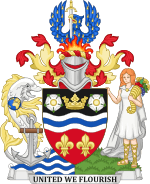 Coat of arms of the county council |
|
Humberside was a county in Northern England that existed from April 1, 1974, to April 1, 1996. It was a "non-metropolitan county," meaning it had a county council that managed local services, and also a "ceremonial county," used for things like the Queen's representatives.
Humberside was created from parts of three older areas: the East Riding of Yorkshire, the West Riding of Yorkshire, and the northern part of Lindsey, Lincolnshire. Its main office was in Beverley, and its biggest city was Kingston upon Hull. Other important towns included Goole, Scunthorpe, Grimsby, Cleethorpes, and Bridlington. The county stretched from one Wold Newton in the north to another Wold Newton in the south.
Humberside shared borders with North Yorkshire to the north and west, South Yorkshire and Nottinghamshire to the south-west, and Lincolnshire to the south. To the east, it faced the North Sea.
When Humberside was ended on April 1, 1996, it was replaced by four new local government areas. These were North Lincolnshire, North East Lincolnshire, Kingston upon Hull, and the East Riding of Yorkshire. Even though the county no longer exists, the name "Humberside" is still used today. You might hear it in the news or see it in the names of organizations like Humberside Police and Humberside Fire and Rescue Service. These groups kept the name because changing it would have been too expensive.
Contents
What's in a Name? The Story of Humberside
The name "Humberside" wasn't very common before the county was created. It was just an informal way to talk about the area around the Humber river. However, by the middle of the 20th century, industries on both sides of the Humber Estuary were growing closer. People started using "Humberside" to describe the important ports of Hull, Grimsby, and Goole, and the land around them.
Local leaders also pushed for the name to be used more widely. They wanted to build a large suspension bridge across the Humber, and using one name helped to unite the two sides of the river.
In 1964, "Humberside" became an official term. It was used when the "Yorkshire and The Humber" planning region was created. This region included most of the old East Riding of Yorkshire, parts of the West Riding of Yorkshire, and parts of Lindsey from Lincolnshire. From then on, the name "Humberside" was actively used to promote the area. In 1971, the new local BBC radio station was even named Radio Humberside.
How Humberside Was Formed
Humberside was officially created on April 1, 1974, under a law called the Local Government Act 1972. This law changed how local government worked across England.
The new county brought together several towns and rural areas. It included the large towns of Kingston upon Hull and Grimsby. From the Lincolnshire side, it added towns like Cleethorpes and Scunthorpe, along with smaller towns and rural areas. From the East Riding of Yorkshire, it included towns like Beverley, Bridlington, and Goole, plus many other smaller places.
Before Humberside was created, there wasn't much connecting the two sides of the Humber river. People had to use ferries or take a very long drive around through Goole. The government promised that the Humber Bridge would make Humberside a more connected place. The bridge was planned to open in 1977 but finally opened on June 24, 1981. This bridge made travel between the north and south sides much easier, cutting the journey from Grimsby to Beverley from nearly 100 miles to about 30 miles. However, even with the bridge, Humberside didn't last forever.
How Humberside Was Governed
Humberside was a "non-metropolitan" county. This meant it had a main council called Humberside County Council. This council worked alongside nine smaller local councils, called "non-metropolitan district councils."
Elections for the county council happened every four years. The first election was in 1973, and the last one was in 1993.
Areas Within Humberside
The county of Humberside was divided into nine smaller areas, known as non-metropolitan districts. These districts helped manage local services within the county.
|
The Humberside Coat of Arms
The Humberside County Council held a competition to design a special coat of arms for the new county. A man named Mr. E. H. Cook won the competition. The official design was approved in 1976.
The shield on the coat of arms was like a map of the county. At the top, there was a gold crown from the city of Hull's arms, placed between two white Yorkshire roses. At the bottom, there were two gold fleurs-de-lis, which represented Lincolnshire. A blue and silver wavy line crossed the middle of the shield, symbolizing the River Humber.
Above the shield was a blue eagle. This eagle came from the old East Riding County Council's arms. It looked like it was rising from flames, showing that a new authority was being created. The eagle's wings had gold droplets, which stood for North Sea Oil. In its beak, it held a sword, representing the steel industry in Scunthorpe.
On either side of the shield were two supporters. One was a silver dolphin holding a globe and an anchor, showing worldwide trade. The other was Ceres, the Roman goddess of harvests, representing the county's farming. They stood on a base that looked like the countryside and coastline of Humberside.
The motto for Humberside was United We Flourish, meaning "together we grow and succeed."
When the county council was ended in 1996, the coat of arms was no longer officially used. However, the Humberside Fire and Rescue Service still uses a part of the shield as its symbol today.
Why Humberside Was Abolished
Humberside was not very popular with everyone. Many people, especially in the Yorkshire parts, wanted it to be abolished almost as soon as it was created. Some local councils even changed their names to include "East Yorkshire" instead of "Humberside."
Boundary signs for Humberside were often damaged by vandals, especially in the East Riding of Yorkshire. People would scratch out "Humberside" or try to change the signs. This got so bad that the county council removed some signs in 1990 to save money on replacing them.
However, not everyone disliked Humberside. People in the port towns like Hull and Grimsby saw the county as a good idea that could bring them together.
In the late 1980s and early 1990s, there were many discussions about whether Humberside should continue to exist. A report in 1990 showed that most people (63%) thought creating Humberside was a "bad" idea, and only a small number (14%) thought it was "good."
Finally, a big review of local government in England decided that Humberside should be abolished. The government agreed with this idea. The law to end Humberside was debated in Parliament in 1995 and officially came into effect on April 1, 1996.
One politician, Michael Brown, who was an MP for Brigg and Cleethorpes, strongly supported ending Humberside. He even said he wanted the word "Humberside" to be removed from the English language!
Few people spoke up to defend Humberside. Elliot Morley, an MP for Glanford and Scunthorpe, said that young people born in Humberside felt a connection to it. But even he agreed that the county council was "a flawed idea."
So, when Humberside was abolished, it was replaced by four new self-governing areas:
- Kingston upon Hull
- East Riding of Yorkshire: This new area included the old Beverley, East Yorkshire, Holderness, and northern Boothferry districts.
- North Lincolnshire: This included the old Glanford, Scunthorpe, and southern Boothferry districts.
- North East Lincolnshire: This included the old Great Grimsby and Cleethorpes districts.
The roles of Lord Lieutenant of Humberside and High Sheriff of Humberside were also ended. The Yorkshire part of Humberside became the new ceremonial county of the East Riding of Yorkshire. The Lincolnshire part went back to being part of Lincolnshire for ceremonial purposes. However, the entire area that was once Humberside is still part of the "Yorkshire and the Humber" region for government purposes.
Humberside and Your Mail
The Royal Mail, which handles postal services, never fully adopted "Humberside" as a single postal county. Instead, from 1975, they divided the area into "North Humberside" and "South Humberside" for sorting mail.
Even after the county was abolished in 1996, these postal names continued to be used in databases. However, people living in the area, especially in the East Riding of Yorkshire, wanted the name "Humberside" removed from their addresses. They were proud to be from the East Riding of Yorkshire, not Humberside.
After many years of protests and campaigns by local MPs and residents, the Royal Mail finally agreed to remove "Humberside" from its address databases. This change happened in July 2014. So, more than 18 years after the county was abolished, "Humberside" officially stopped being a postal destination.
Humberside's Lasting Impact
Even though Humberside as a county no longer exists, the name is still used by some important organizations. For example, we still have Humberside Police, Humberside Airport, Humberside Fire Service, Humberside Scouts, and BBC Radio Humberside. These groups often kept the name because changing it would have been too expensive.
The Humber Enterprise Zone
The area that used to be Humberside is now known as the "Hull and Humber Ports City Region." This area is important for economic development. In 2012, the "Humber Enterprise Zone" was launched. This zone includes 16 sites around the Humber Estuary, covering a large area.
The Enterprise Zone focuses on marine engineering and renewable energy, especially offshore wind power. It's designed to attract large manufacturers and businesses that support them, helping the economy grow in the region.
Images for kids


